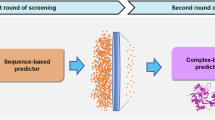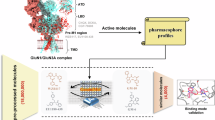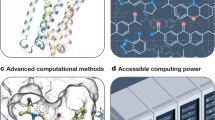Abstract
GluN3A-containing NMDA receptors have recently emerged as promising therapeutic targets for neurological disorders. However, discovering potent modulators remains a significant challenge, primarily due to the limitations of traditional high-throughput screening methods. In this study, we introduce a novel drug-target affinity prediction method, CLG-DTA, designed to enhance drug discovery for the GluN1/GluN3A receptor. This graph contrastive learning-based method incorporates natural language supervision by transforming regression labels into textual representation, and integrating them with traditional affinity data to enhance molecular representation. Additionally, a numerical knowledge graph is employed to refine continuous text embeddings, enabling precise modeling of complex drug-target interactions across diverse data modalities. Using CLG-DTA, we screened a library of 18 million compounds and identified 12 candidates for experimental validation. Among them, five compounds exhibited significant activity, with Boeravinone E demonstrating the highest potency (\({{{\rm{IC}}}}_{50}\) = 3.40 \(\pm\) 0.91 μM). These findings highlight the potential of CLG-DTA in accelerating the identification of promising GluN1/GluN3A modulators and lay a robust foundation for future therapeutic development.
This is a preview of subscription content, access via your institution
Access options
Subscribe to this journal
Receive 12 print issues and online access
269,00 € per year
only 22,42 € per issue
Buy this article
- Purchase on SpringerLink
- Instant access to full article PDF
Prices may be subject to local taxes which are calculated during checkout






Similar content being viewed by others
References
Das S, Sasaki YF, Rothe T, Premkumar LS, Takasu M, Crandall JE, et al. Increased NMDA current and spine density in mice lacking the NMDA receptor subunit NR3A. Nature. 1998;393:377–81.
Perez-Otano I, Schulteis CT, Contractor A, Lipton SA, Trimmer JS, Sucher NJ, et al. Assembly with the NR1 subunit is required for surface expression of NR3A-containing NMDA receptors. J Neurosci. 2001;21:1228–37.
Chatterton JE, Awobuluyi M, Premkumar LS, Takahashi H, Talantova M, Shin Y, et al. Excitatory glycine receptors containing the NR3 family of NMDA receptor subunits. Nature. 2002;415:793–8.
Ciabarra AM, Sullivan J, Gahn LG, Pecht G, Heinemann S, Sevarino KA. Cloning and characterization of chi-1: a developmentally regulated member of a novel class of the ionotropic glutamate receptor family. J Neurosci. 1995;15:6498–508.
Sucher NJ, Akbarian S, Chi CL, Leclerc CL, Awobuluyi M, Deitcher DL, et al. Developmental and regional expression pattern of a novel NMDA receptor-like subunit (NMDAR-L) in the rodent brain. J Neurosci. 1995;15:6509–20.
Sasaki YF, Rothe T, Premkumar LS, Das S, Cui J, Talantova MV, et al. Characterization and comparison of the NR3A subunit of the NMDA receptor in recombinant systems and primary cortical neurons. J Neurophysiol. 2002;87:2052–63.
Seki T, Namba T, Mochizuki H, Onodera M. Clustering, migration, and neurite formation of neural precursor cells in the adult rat hippocampus. J Comp Neurol. 2007;502:275–90.
Murillo A, Navarro AI, Puelles E, Zhang Y, Petros TJ, Pérez-Otaño I. Temporal dynamics and neuronal specificity of Grin3a expression in the mouse forebrain. Cereb Cortex. 2021;31:1914–26.
Mueller HT, Meador-Woodruff JH. NR3A NMDA receptor subunit mRNA expression in schizophrenia, depression and bipolar disorder. Schizophr Res. 2004;71:361–70.
Marco S, Giralt A, Petrovic MM, Pouladi MA, Martínez-Turrillas R, Martínez-Hernández J, et al. Suppressing aberrant GluN3A expression rescues NMDA receptor dysfunction, synapse loss and motor and cognitive decline in Huntington’s disease models. Nat Med. 2013;19:1030.
Pfisterer U, Petukhov V, Demharter S, Meichsner J, Thompson JJ, Batiuk MY, et al. Identification of epilepsy-associated neuronal subtypes and gene expression underlying epileptogenesis. Nat Commun. 2020;11:5038.
Yuan T, Mameli M, O’Connor EC, Dey PN, Verpelli C, Sala C, et al. Expression of cocaine-evoked synaptic plasticity by GluN3A-containing NMDA receptors. Neuron. 2013;80:1025–38.
Bossi S, Pizzamiglio L, Paoletti P. Excitatory GluN1/GluN3A glycine receptors (eGlyRs) in brain signaling. Trends Neurosci. 2023;46:667–81.
Grand T, Abi Gerges S, David M, Diana MA, Paoletti P. Unmasking GluN1/GluN3A excitatory glycine NMDA receptors. Nat Commun. 2018;9:4769.
Otsu Y, Darcq E, Pietrajtis K, Mátyás F, Schwartz E, Bessaih T, et al. Control of aversion by glycine-gated GluN1/GluN3A NMDA receptors in the adult medial habenula. Science. 2019;366:250–4.
Bossi S, Dhanasobhon D, Ellis-Davies GC, Frontera J, Van Velze MdB, Lourenco J, et al. GluN3A excitatory glycine receptors control adult cortical and amygdalar circuits. Neuron. 2022;110:2438–54.
Zeng Y, Zheng Y, Zhang T, Ye F, Zhan L, Kou Z, et al. Identification of a subtype- selective allosteric inhibitor of GluN1/GluN3 NMDA receptors. Front Pharmacol. 2022;13:888308.
Hemelikova K, Kolcheva M, Skrenkova K, Kaniakova M, Horak M. Lectins modulate the functional properties of GluN1/GluN3-containing NMDA receptors. Neuropharmacology. 2019;157:107671.
Kvist T, Greenwood JR, Hansen KB, Traynelis SF, Bräuner-Osborne H. Structure- based discovery of antagonists for GluN3-containing N-methyl-D-aspartate receptors. Neuropharmacology. 2013;75:324–36.
Zhu Z, Yi F, Epplin MP, Liu D, Summer SL, Mizu R, et al. Negative allosteric modulation of GluN1/GluN3 NMDA receptors. Neuropharmacology. 2020;176:108117.
Zhang Y, Hu Y, Han N, Yang A, Liu X, Cai H. A survey of drug-target interaction and affinity prediction methods via graph neural networks. Computers Biol Med. 2023;163:107136.
Wu H, Liu J, Jiang T, Zou Q, Qi S, Cui Z, et al. AttentionMGT-DTA: A multi-modal drug-target affinity prediction using graph transformer and attention mechanism. Neural Netw. 2024;169:623–36.
Bai G, Pan Y, Zhang Y, Li Y, Wang J, Wang Y, et al. Research advances of molecular docking and molecular dynamic simulation in recognizing interaction between muscle proteins and exogenous additives. Food Chem. 2023;429:136836.
Asiamah I, Obiri SA, Tamekloe W, Armah FA, Borquaye LS. Applications of molecular docking in natural products-based drug discovery. Sci Afr. 2023;20:e01593.
Agu P, Afiukwa C, Orji O, Ezeh E, Ofoke I, Ogbu C, et al. Molecular docking as a tool for the discovery of molecular targets of nutraceuticals in diseases management. Sci Rep. 2023;13:13398.
Rácz A, Bajusz D, Héberger K. Effect of dataset size and train/test split ratios in QSAR/QSPR multiclass classification. Molecules. 2021;26:1111.
Gentile F, Agrawal V, Hsing M, Ton AT, Ban F, Norinder U, et al. Deep docking: a deep learning platform for augmentation of structure based drug discovery. ACS Cent Sci. 2020;6:939–49.
Mohanty M, Mohanty PS. Molecular docking in organic, inorganic, and hybrid systems: a tutorial review. Monatshefte für Chem-Chem Monthly. 2023;154:683–707.
Kamal IM, Chakrabarti S. MetaDOCK: a combinatorial molecular docking approach. ACS Omega. 2023;8:5850–60.
Neves BJ, Braga RC, Melo-Filho CC, Moreira-Filho JT, Muratov EN, Andrade CH. QSAR-based virtual screening: advances and applications in drug discovery. Front Pharmacol. 2018;9:1275.
Wu Z, Zhu M, Kang Y, Leung ELH, Lei T, Shen C, et al. Do we need different machine learning algorithms for QSAR modeling? A comprehensive assessment of 16 machine learning algorithms on 14 QSAR data sets. Brief Bioinforma. 2021;22:bbaa321.
Du L, Geng C, Zeng Q, Huang T, Tang J, Chu Y, et al. Dockey: a modern integrated tool for large-scale molecular docking and virtual screening. Brief Bioinform. 2023;24:bbad047.
Jayapriya J, Arock M. Aligning molecular sequences by wavelet transform using cross correlation similarity metric. Int J Intell Syst Appl(IJISA). 2017;9:62–70.
Anakal S, Sandhya P. Decision support system for drug-drug interaction pertaining to COPD and its comorbidities. Int J Educ Manag Eng. 2022;12:1.
Muhammed MT, Aki-Yalcin E. Molecular docking: principles, advances, and its applications in drug discovery. Lett Drug Des Discov. 2024;21:480–95.
Lewis RA, Wood D. Modern 2D QSAR for drug discovery. Wiley Interdiscip Rev: computational Mol Sci. 2014;4:505–22.
Chen S, Xue D, Chuai G, Yang Q, Liu Q. FL-QSAR: a federated learning-based QSAR prototype for collaborative drug discovery. Bioinformatics. 2020;36:5492–8.
Tropsha A, Isayev O, Varnek A, Schneider G, Cherkasov A. Integrating QSAR modelling and deep learning in drug discovery: the emergence of deep QSAR. Nat Rev Drug Discov. 2024;23:141–55.
Li K, Liu W, Luo Y, Cai X, Wu J, Hu W. Zero-shot Learning for Preclinical Drug Screening. In: Larson K, editor. Proceedings of the Thirty-Third International Joint Conference on Artificial Intelligence, IJCAI-24. International Joint Conferences on Artificial Intelligence Organization; 2024. p. 2117-25. Main Track. Available from: https://doi.org/10.24963/ijcai.2024/234.
Özçelik R, Bag A, Atil B, Barsbey M, Özgür A, Ozkirimli E. A framework for improving the generalizability of drug-target affinity prediction models. J Comput Biol. 2023;30:1226–39.
Li T, Zhao XM, Li L. Co-VAE: Drug-target binding affinity prediction by co-regularized variational autoencoders. IEEE Trans Pattern Anal Mach Intell. 2021;44:8861–73.
Monteiro NR, Oliveira JL, Arrais JP. TAG-DTA: Binding-region-guided strategy to predict drug-target affinity using transformers. Expert Syst Appl. 2024;238:122334.
Li K, Gong X, Wu J, Hu W. Contrastive learning drug response models from natural language supervision. In: Larson K, editor. Proceedings of the Thirty-Third International Joint Conference on Artificial Intelligence, IJCAI-24. International Joint Conferences on Artificial Intelligence Organization; 2024. p. 2126–34. Main Track. Available from: https://doi.org/10.24963/ijcai.2024/235.
Li YC, You ZH, Yu CQ, Wang L, Wong L, Hu L, et al. PPAEDTI: personalized propagation auto-encoder model for predicting drug-target interactions. IEEE J Biomed Health Inform. 2022;27:573–82.
Zha K, Cao P, Son J, Yang Y, Katabi D. Rank-n-contrast: learning continuous representations for regression. Adv Neural Info Proc Syst. 2024;36:17882–903.
Davis MI, Hunt JP, Herrgard S, Ciceri P, Wodicka LM, Pallares G, et al. Comprehensive analysis of kinase inhibitor selectivity. Nat Biotechnol. 2011;29:1046–51.
He T, Heidemeyer M, Ban F, Cherkasov A, Ester M. SimBoost: a read-across approach for predicting drug-target binding affinities using gradient boosting machines. J Cheminform. 2017;9:1–14.
Tang J, Szwajda A, Shakyawar S, Xu T, Hintsanen P, Wennerberg K, et al. Making sense of large-scale kinase inhibitor bioactivity data sets: a comparative and integrative analysis. J Chem Inf Modeling. 2014;54:735–43.
Zhang S, Tong H, Xu J, Maciejewski R. Graph convolutional networks: a comprehensive review. Comput Soc Netw. 2019;6:1–23.
Han K, Xiao A, Wu E, Guo J, Xu C, Wang Y. Transformer in transformer. Adv Neural Inf Process Syst. 2021;34:15908–19.
Halgren T. New method for fast and accurate binding-site identification and analysis. Chem Biol Drug Des. 2007;69:146–8.
Friesner RA, Banks JL, Murphy RB, Halgren TA, Klicic JJ, Mainz DT, et al. Glide: a new approach for rapid, accurate docking and scoring. 1. Method and assessment of docking accuracy. J Med Chem. 2004;47:1739–49.
Shelley JC, Cholleti A, Frye LL, Greenwood JR, Timlin MR, Uchimaya M. Epik: a software program for pK a prediction and protonation state generation for drug-like molecules. J Computer-aided Mol Des. 2007;21:681–91.
Kinnings SL, Liu N, Tonge PJ, Jackson RM, Xie L, Bourne PE. A machine learning-based method to improve docking scoring functions and its application to drug repurposing. J Chem Inf Modeling. 2011;51:408–19.
Ballester PJ, Mitchell JB. A machine learning approach to predicting protein–ligand binding affinity with applications to molecular docking. Bioinformatics. 2010;26:1169–75.
Li H, Leung KS, Wong MH, Ballester PJ. Low-quality structural and interaction data improves binding affinity prediction via random forest. Molecules. 2015;20:10947–62.
Rogers D, Hahn M. Extended-connectivity fingerprints. J Chem Inf Modeling. 2010;50:742–54.
Cao DS, Xu QS, Liang YZ. propy: a tool to generate various modes of Chou’s PseAAC. Bioinformatics. 2013;29:960–2.
Wang S, Song X, Zhang Y, Zhang K, Liu Y, Ren C, et al. MSGNN-DTA: multi-scale topological feature fusion based on graph neural networks for drug-target binding affinity prediction. Int J Mol Sci. 2023;24:8326.
Vrahatis AG, Lazaros K, Kotsiantis S. Graph attention networks: a comprehensive review of methods and applications. Future Internet. 2024;16:318.
Chu Z, Huang F, Fu H, Quan Y, Zhou X, Liu S, et al. Hierarchical graph representation learning for the prediction of drug-target binding affinity. Inf Sci. 2022;613:507–23.
Cohen I, Huang Y, Chen J, Benesty J, Benesty J, Chen J, et al. Pearson correlation coefficient. In: Noise Reduction in Speech Processing. Springer Topics in Signal Processing, Vol 2. Berlin, Heidelberg: Springer; 2009. p. 1–4. https://doi.org/10.1007/978-3-642-00296-0_5.
Sedgwick P. Spearman’s rank correlation coefficient. BMJ. 2014;349:g7327.
Harrell JrFE, Lee KL, Mark DB. Multivariable prognostic models: issues in developing models, evaluating assumptions and adequacy, and measuring and reducing errors. Stat Med. 1996;15:361–87.
Liu T, Lin Y, Wen X, Jorissen RN, Gilson MK. BindingDB: a web-accessible database of experimentally determined protein–ligand binding affinities. Nucleic Acids Res. 2007;35:D198–D201.
Zhang M, Chen T, Lu X, Lan X, Chen Z, Lu S. G protein-coupled receptors (GPCRs): advances in structures, mechanisms and drug discovery. Signal Transduct Target Ther. 2024;9:88.
Borrelli F, Ascione V, Capasso R, Izzo AA, Fattorusso E, Taglialatela-Scafati O. Spasmolytic effects of nonprenylated rotenoid constituents of Boerhaavia diffusa Roots. J Nat Products. 2006;69:903–6.
Linghu L, Fan H, Hu Y, Zou Y, Yang P, Lan X, et al. Mirabijalone E: a novel rotenoid from Mirabilis himalaica inhibited A549 cell growth in vitro and in vivo. J Ethnopharmacol. 2014;155:326–33.
Borrelli F, Milic N, Ascione V, Capasso R, Izzo AA, Capasso F, et al. Isolation of new rotenoids from Boerhaavia diffusa and evaluation of their effect on intestinal motility. Planta Med. 2005;71:928–32.
Liu T, Ren Q, Wang S, Gao J, Shen C, Zhang S, et al. Chemical modification of polysaccharides: a review of synthetic approaches, biological activity and the structure–activity relationship. Molecules. 2023;28:6073.
Li F, Deng H, Renata H. Chemoenzymatic approaches for exploring structure–activity relationship studies of bioactive natural products. Nat Synth. 2023;2:708–18.
Ancajas CMF, Oyedele AS, Butt CM, Walker AS. Advances, opportunities, and challenges in methods for interrogating the structure activity relationships of natural products. Nat Product Rep. 2024;41:1543–78.
Shalini R, Mohan R. Drugs relationship discovery using hypergraph. Int J Inf Technol Comput Sci. 2018;10:54–63.
Schlick T, Portillo-Ledesma S. Biomolecular modeling thrives in the age of technology. Nat Comput Sci. 2021;1:321–31.
Dawson KA, Yan Y. Current understanding of biological identity at the nanoscale and future prospects. Nat Nanotechnol. 2021;16:229–42.
Petrén H, Köllner TG, Junker RR. Quantifying chemodiversity considering biochemical and structural properties of compounds with the R package chemodiv. N Phytologist. 2023;237:2478–92.
Naishima NL, Faizan S, Raju RM, Sruthi ASVL, Veena N, Sharma GK, et al. Design, synthesis, analysis, evaluation of cytotoxicity against MCF-7 breast cancer cells, 3D QSAR studies and EGFR, HER2 inhibition studies on novel biginelli 1, 4-dihydropyrimidines. J Mol Struct. 2023;1277:134848.
Bai Q, Liu S, Tian Y, Xu T, Banegas-Luna AJ, Pérez-Sánchez H, et al. Application advances of deep learning methods for de novo drug design and molecular dynamics simulation. Wiley Interdiscip Rev: Comput Mol Sci. 2022;12:e1581.
Al-Majmar NA, Mohsen AA, Al-Thulathi MS. Development a model for drug interaction prediction based on patient state. Int J Intell Syst Appl. 2022;13:28.
Tazeen N, Rani KS. A novel ant colony based DBN framework to analyze the drug reviews. Int J Intell Syst Appl. 2021;13:25.
Devi RV, Sathya SS, Kumar N, Coumar MS. Multi-objective monkey algorithm for drug design. Int J Intell Syst Appl. 2019;11:31.
Nag A, Karforma S. Adaptive dictionary-based compression of protein sequences. Int J Educ Manag Eng. 2017;5:1–6.
Mohamed EM. Enhanced PROBCONS for multiple sequence alignment in cloud computing. IJ Inf Technol Computer Sci. 2019;9:38–47.
Majumder A. Multiple features based approach to extract bio-molecular event triggers using conditional random field. Int J Intell Syst Appl. 2012;4:41.
Cerna PD, Abdulahi TJ, Abdulahi T. Prediction of anti-retroviral drug consumption for HIV patient in hospital pharmacy using data mining technique. Int J Inf Technol Computer Sci. 2016;8:52–9.
Liu Y, Aickelin U. Feature selection in detection of adverse drug reactions from the Health Improvement Network (THIN) database. Int J Inf Technol Comput Sci. 2015;7:68–85.
Pashaa MK, Munawara K, Qureshib AT. Application of the docking protocol optimization for inhibitors of IGF-1R and IR and understanding them through artificial intelligence and bibliography. IJ Educ Manag Eng. 2021;4:1–11.
Ye Q, Hsieh CY, Yang Z, Kang Y, Chen J, Cao D, et al. A unified drug-target interaction prediction framework based on knowledge graph and recommendation system. Nat Commun. 2021;12:6775.
Acknowledgements
The work was supported in part by the National Key Research and Development Program of China (2023YFC2705700 to WBH), the Strategic Priority Research Program of the Chinese Academy of Sciences (XDB0830403 to ZBG), National Science Foundation of China (No. 62476203 to WBH), the Guangdong Provincial Natural Science Foundation General Project (No. 2025A1515012155 to WBH), the National Science and Technology Innovation 2030 Major Program (2021ZD0200900), Open Fund for Research Projects of the Ministry of Education Key Laboratory of Embedded System and Service Computing, Tongji University (No. ESSCKF2024-01), and Key Program of Hubei Natural Science Foundation Traditional Chinese Medicine Innovation and Development Joint Fund (2025AFD470).
Author information
Authors and Affiliations
Contributions
WBH and ZBG designed the study. KL, YDX, Yan Z, BD, and WBH developed the computational methods. Yue Z, HCW, and SF performed the activity validation. ZYQ and YDX conducted homology modeling and molecular docking analyses. KL, Yue Z, ZBG, and WBH drafted the original manuscript. KL, Yue Z, YDX, HCW, SF, Yue Z, BD, ZBG, and WBH edited and reviewed the manuscript before submission.
Corresponding authors
Ethics declarations
Competing interests
The author declares no competing interests.
Additional information
Publisher’s note Springer Nature remains neutral with regard to jurisdictional claims in published maps and institutional affiliations.
Supplementary information
Rights and permissions
Springer Nature or its licensor (e.g. a society or other partner) holds exclusive rights to this article under a publishing agreement with the author(s) or other rightsholder(s); author self-archiving of the accepted manuscript version of this article is solely governed by the terms of such publishing agreement and applicable law.
About this article
Cite this article
Li, K., Zeng, Y., Xiong, Yd. et al. Contrastive learning-based drug screening model for GluN1/GluN3A inhibitors. Acta Pharmacol Sin (2025). https://doi.org/10.1038/s41401-025-01580-0
Received:
Accepted:
Published:
DOI: https://doi.org/10.1038/s41401-025-01580-0



